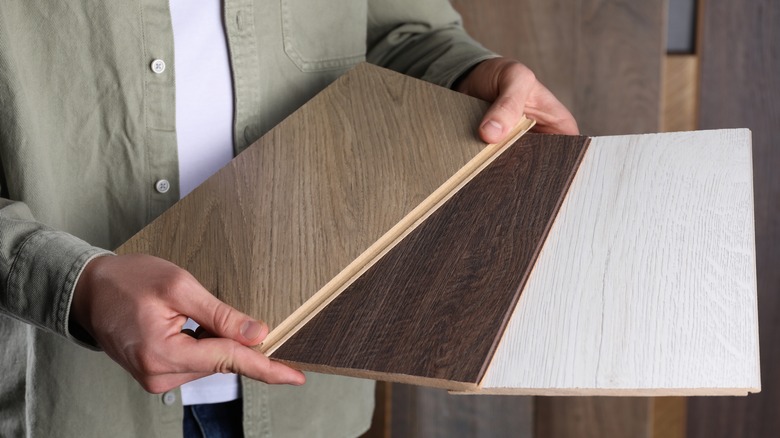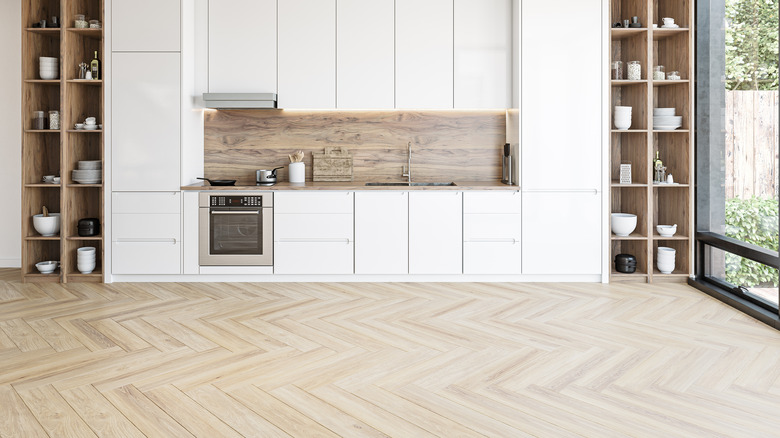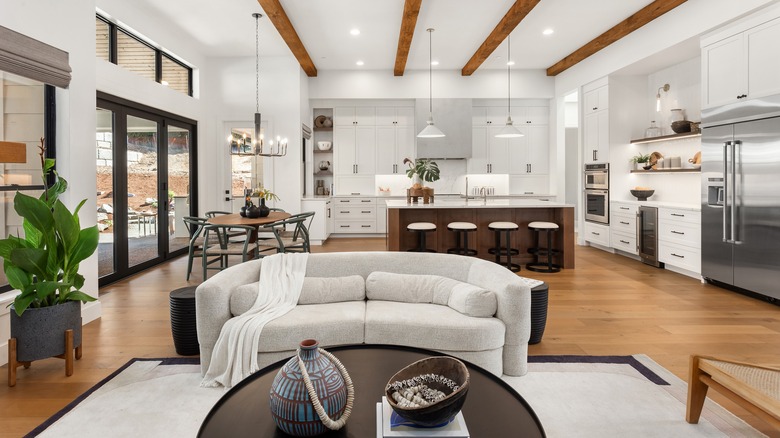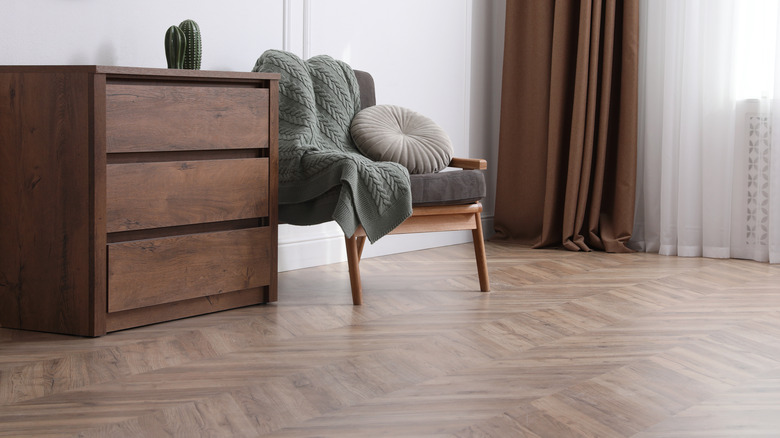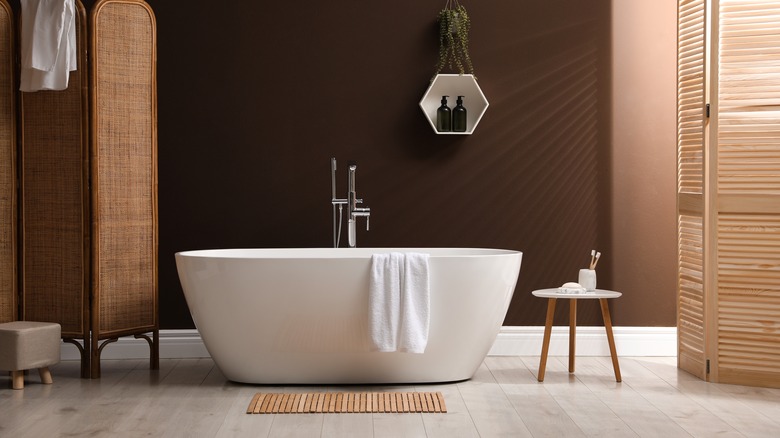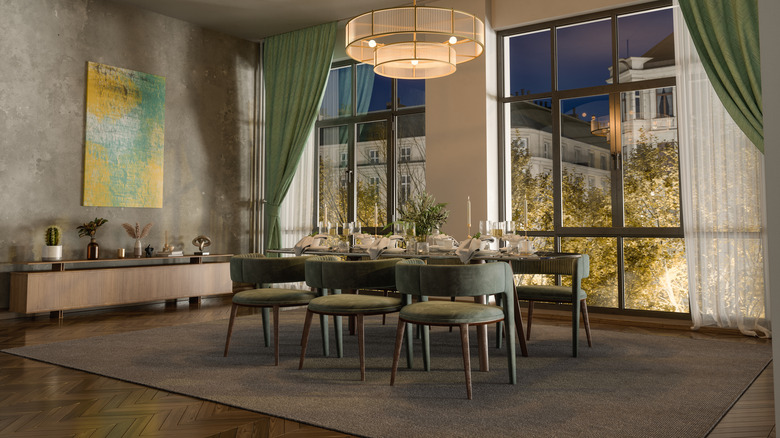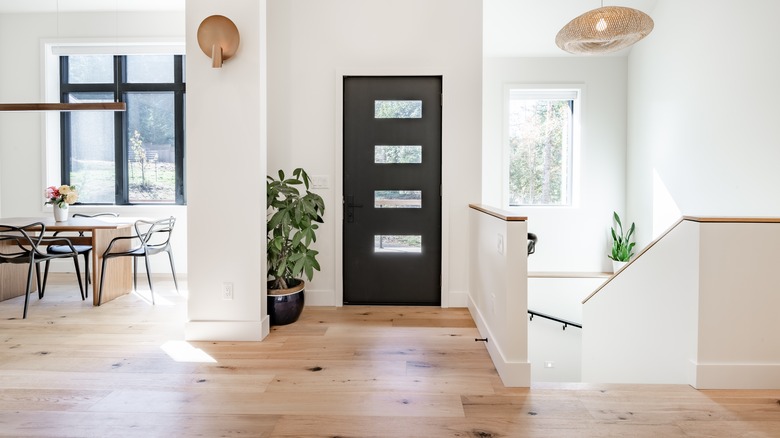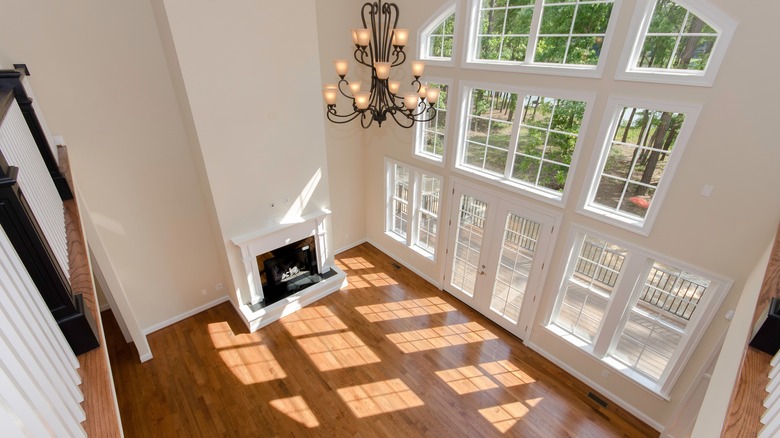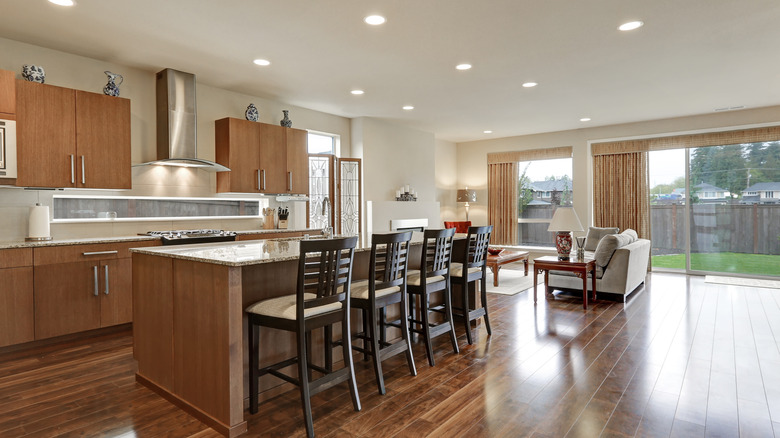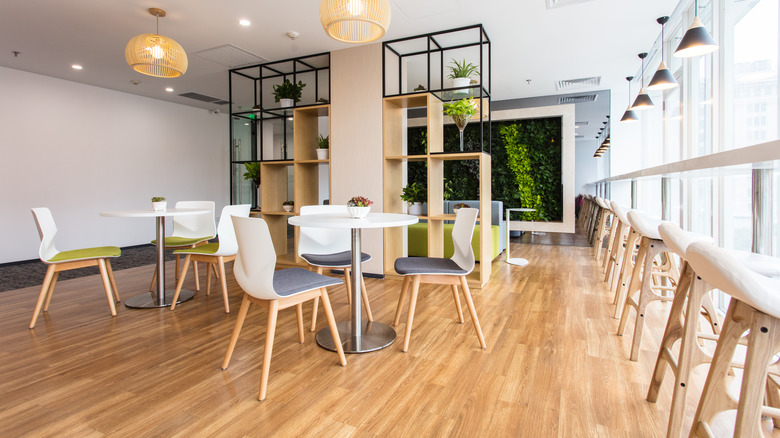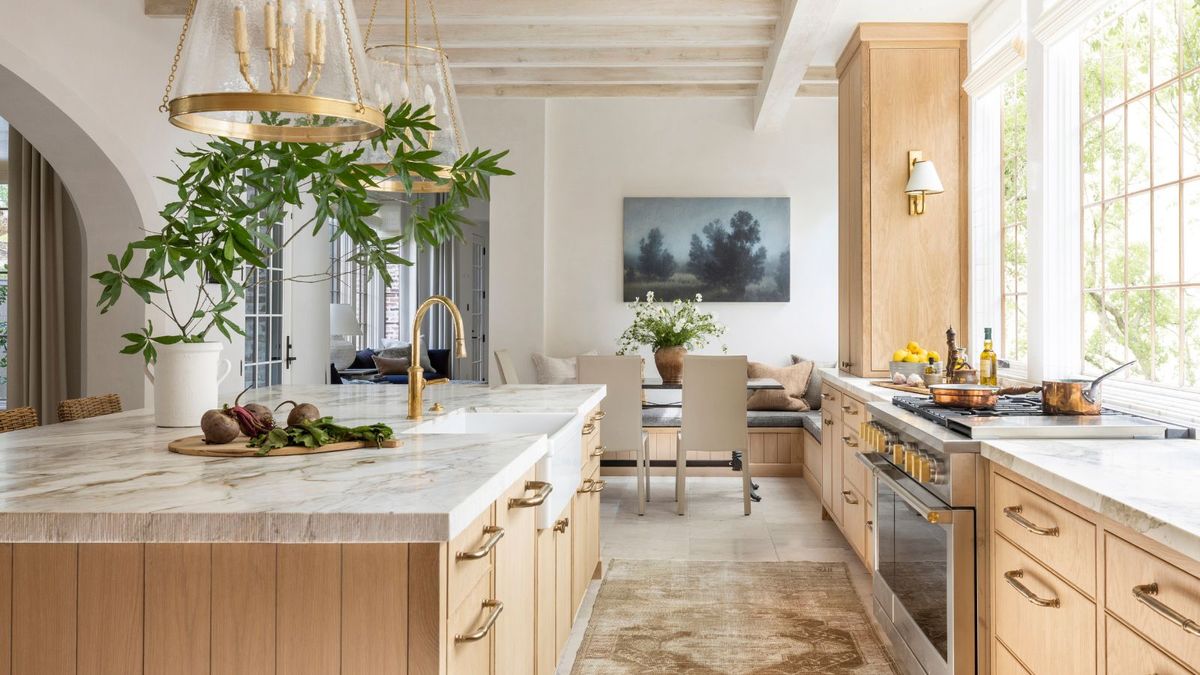The Best Hardwood Floor Colors, According To Design Experts
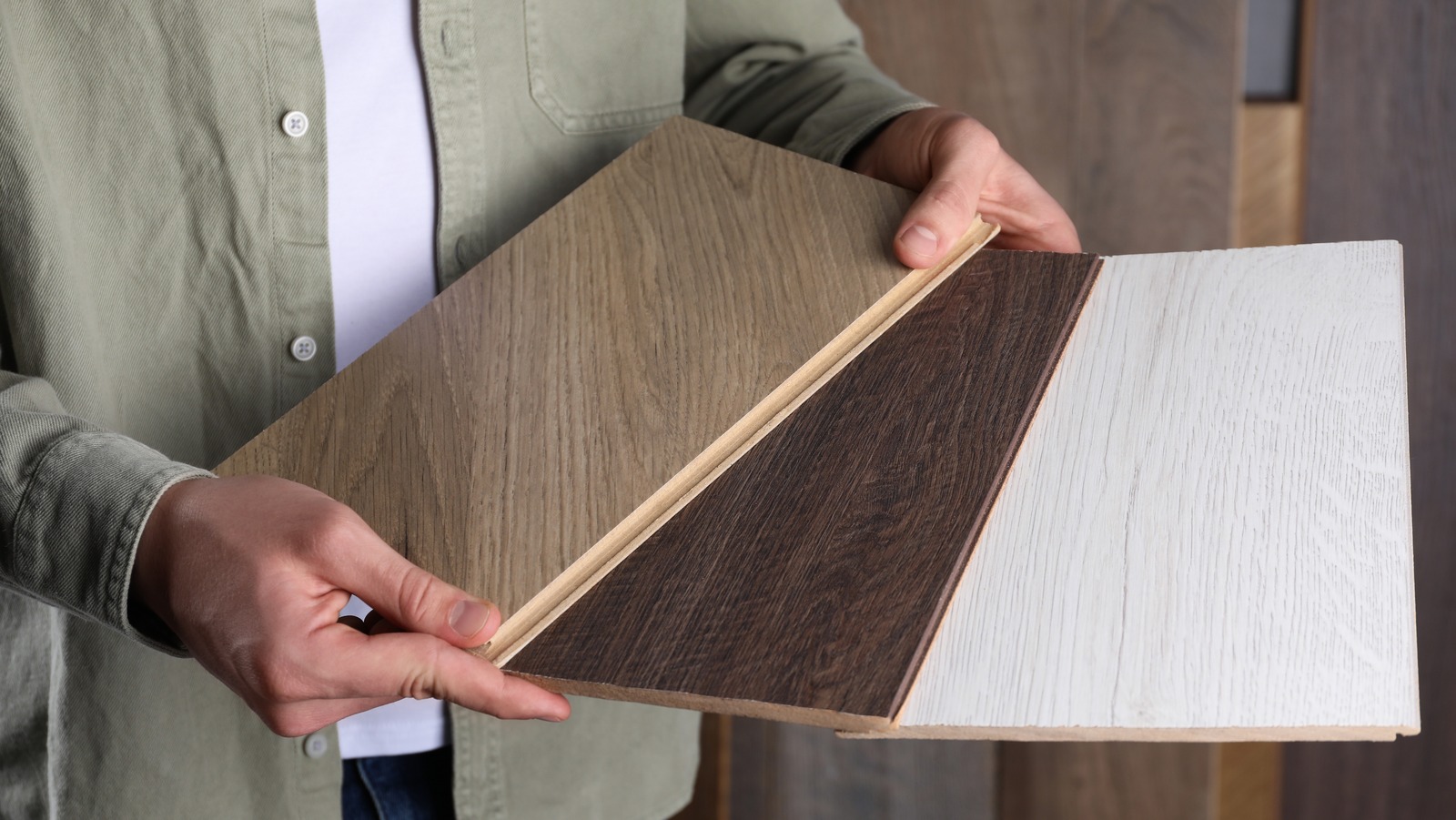
Whether you’re building a new home or renovating an existing one, choosing flooring is an important step when it comes to creating an attractive overall design. Wood flooring contributes value and warmth to a home. Not only do homeowners recover 118% of their cost when installing new planks before reselling, according to a National Association of Realtors study, but they also add texture and dimension to your space. But, with many types of wood and multiple finishes available, the process of selecting a color may leave you confused and exhausted. That’s why we’ve collected recommendations from interior design experts for the best ones to consider.
The types of wood used for flooring include oak, maple, cherry, walnut, and more. Many manufacturers are also creating engineered hardwood flooring, which has the look of wood but is more resilient thanks to its wood veneer coating. All of these variables create a wide array of flooring colors available on the market. So how do you choose the best one for your space? Believe it or not, it doesn’t just depend on color. The hue you choose also depends on that shade’s versatility, durability, and decor cohesiveness, just to name a few. To help you wade through all of the options, our design experts shared the pros and cons of each shade, as well as a breakdown of which to choose depending on your circumstances. Here is a breakdown of the best colors to consider for your remodel.
Light natural oak is a timeless flooring option
Oak flooring is considered a classic choice that never goes out of style — which is great, considering it typically lasts up to 25 to 30 years. It’s the best option to give your home a fresh, modern feel that’s still warm and welcoming. Part of the reason it’s so inviting is because it showcases the wood’s texture, bringing a little bit of nature indoors. “A light, natural finish allows the authentic beauty of the wood grain to shine through,” Brad Smith of Omni Home Ideas exclusively tells House Digest.
If you’d like to bring new life to a choppy, outdated layout, natural oak can give it a brighter, more modern feel. “Lighter woods like oak and maple can make a room feel more open and airy, perfect for smaller or darker spaces,” states Artem Kropovinsky, interior designer and founder of Arsight, when speaking to House Digest. The timeless color can also allow for future decor evolutions, as Smith emphasizes, “It’s also versatile, pairing well with both cool and warm decor.”
One of our favorite reasons for choosing a natural oak flooring isn’t so much about modernizing or opening a room, though. It’s because oak flooring is neutral-toned and lets other room accents take center stage. It’s subtle and unobtrusive tones won’t compete for attention in rooms with bold, boho-chic wallpapers or your favorite pieces of accent furniture.
Warm honey floors infuse charm
One of the most attractive qualities of hardwood floors is that they bring a welcoming charm to your home. If creating an undeniable cozy atmosphere is your goal, a warm honey finish is a perfect option to reinforce the congenial vibe. “Warm honey-toned hardwood brings warmth and coziness to a room and is compatible with a broad range of decor styles,” Smith exclusively tells House Digest. Because of that, it pairs best with homey aesthetics that make you want to stay in all day. Think Georgian, or colonial designs, which encourage the use of overstuffed couches, giant tables, and a plethora of pillows and sitting nooks. Design-wise, it’s also a good option if you don’t want a color on either end of the spectrum. “This is a perfect middle-ground between too light and too dark,” says Smith.
Even in more contemporary aesthetics, the flooring still has its place. Interior designer Jane Lockhart explains the reemergence of honey-toned floors on her blog saying, “…but yes, it’s back, adding a warm, positive glow to drab grey rooms and bland white spaces.” The expert recommends using neutral white walls and contrasts like black or charcoal furniture and textiles to modernize the classically-colored planks.
Smith also explains more practical points about the choice saying, “It’s also fairly good at concealing minor damages and dirt.” This makes it great for high-traffic areas and busy homes with kids and pets. Floors in this color tend to appear cleaner with less effort, ideal for those looking for a low-maintenance option. Opt for a lower sheen finish to add to their dirt-concealing abilities.
Medium-tone wood can be an ideal compromise
If you’re someone who gets overwhelmed by a flux of options or just want something easy to deal with, go for a medium-toned wood floor. It’s a perfect blend of positives from both sides of the color spectrum: it hides dust and hair like light-colored floors yet borrows a bit of boldness from the darker woods. Plus, it’s a top shade for its versatility, as it offers endless design possibilities. This is a great choice if you like to switch up your decor styles or your room’s hues frequently. As Kropovinsky explained to House Digest, “It’s one of the most versatile palettes, working with both warm and cool color schemes.”
Thanks to its versatility, medium-tone flooring can provide a reliable anchor for multiple decor and color options. For instance, it is perfect for French country, traditional, or mid-century modern aesthetics, all of which are wildly different. However, in low-sheen finishes, it can also look stunning in homes with rustic, modern, or even industrial vibes. It’s a bit of a chameleon, adapting to whatever decor you mix it with.
From a maintenance standpoint, it’s also a top choice for busy spaces and lively homes. While some light-colored flooring can lose its stain over time, and dark floors can highlight dust and debris, a medium tone lands right in the middle. Kropovinsky says, “Medium-tone woods, such as hickory or cherry, offer a balance between showing wear and providing a rich, warm ambiance.”
Whitewashed wood flooring creates airy vibes
Whitewashing is a centuries-old process where a transparent white stain is applied to lighten the color of the wood. This is not an opaque color choice, as it allows the beauty of the wood grain to come through. This is a top choice for anyone wanting to get creative with their flooring. The finish injects texture into space while still allowing you the freedom to play with color. When it comes to the whitewashed look, engineered hardwood floors are the best bet. True whitewashed wood finishes can get scuffed up and even rub off over time. But, with engineered flooring, you’ll still get the same look but with a durable, easy-to-clean finish.
There’s no denying the distinct laid-back vibe this floor creates. As Smith tells House Digest, “This color is particularly popular in coastal or rustic-style homes. Whitewashed hardwood offers a relaxed, airy feel.” It’s great at instantly conveying a theme, so if you really want to hit home that your space is casual and tranquil, this is your best bet.
If you’d prefer to stick to natural wood flooring rather than engineered, you’ll need to consider which type of wood to work with, as each has its pros and cons. Interior stylist and flooring specialist Jeandré du Toit explains on her blog, “Many clients like the look of a white washed Douglas fir but Douglas fir is not as hard as Oak and it shows up scuff marks and loses lustre quite quickly and for a family home you need a floor that will cope with the daily traffic…If you want to achieve that washed chalky aesthetic, I advise all my clients (including the designers) to rather opt for a Prime Oak in a wide board with subtle white wash.”
Dark wood is sleek and sophisticated
If you’re looking to make a space feel more refined and formal, dark flooring can be an ideal option. As Kropovinsky says when speaking to House Digest, “Dark wood floors like walnut or mahogany add a sense of luxury and sophistication to a space.” This intense shade is a top choice for styles that revolve around accessible elegance. It’s a perfect way to infuse a posh feel into a functional home. Dark floors can also be the basis of a variety of looks. They can be paired with deep paint hues for a moody and dramatic vibe. Or, play off their intense hue with bright, neutral tones. As Kropovinsky explains, “They pair beautifully with light-colored furniture and decor, offering a striking contrast.”
As an added bonus, a dark finish disguises imperfections in the wood. And, when you opt for a low-sheen finish, the deep hue can hide spills and dirt. Dark finishes are also more resistant to fading from the sunlight. This means you can retain their deep color and tone longer without the expensive — and messy — refinishing process.
Walnut, in particular, is an excellent choice for those who want a classic look without sacrificing that cozy feeling. “Walnut hardwood flooring has always been a popular choice for designers wishing to add a luxurious look to their projects [due] to the range of colour and natural variation within the wood”, du Toit tells her blog readers. However, she emphasizes the importance of understanding that different walnut wood sources can have shifts in hue that make a difference in the final look. “European walnut tends to have a more orange-brownish tinge and North American walnut has a rich purplish-brown patina with streaks of blonde through it from the sapwood. In general, North American walnut tends to be more popular.”
Distressed and reclaimed wood floors add character with minimal maintenance
If you are conscious about reusing and recycling the materials we consume, turn to reclaimed wood for flooring options that are both attractive and sustainable. Distressed and reclaimed wood floors have a story to tell and are a great way to incorporate a bit of history into your design, particularly if you know its original source. The most distinct part of this flooring is the stunning, one-of-a-kind imperfections. This is also a maintenance perk, as Kropovinsky explains to House Digest, “For those concerned about visible scratches or wear and tear, distressed or reclaimed wood is an excellent choice as it comes pre-aged and full of character.”
However, as Kropovinsky points out, “Color varies widely, offering a versatile option that can complement many design styles.” This means you can work it into nearly any design. You just have to choose the correct stain to coordinate with your existing aesthetic.
It’s is a great choice for those that love earthy styles, like rustic, bohemian, or coastal aesthetics. And, of course, it’s rustic look complements country and antique decor. However, with the a lighter stain and matte finish, it can look just as good in a minimalist or modern space.
Don’t forget to consider your lifestyle before choosing a floor color
When you’re debating between floor colors, there are a few things to consider to ensure you’ll be able to enjoy your new floors for years. One of the most important factors is what your cleaning routine is like. If you’re someone who wants your home to look tidy and you have a routine vacuum regimen, a darker wood floor would look fantastic. If, however, you’re a little more lax with your cleaning routine and don’t want to deal with the upkeep, then opt for a lighter wood since it’s less prone to show dirt or debris than darker tones.
Another factor to consider is the wear and tear your flooring will accumulate over time, particularly if you’ve got little feet or paws running laps around your home. Light wood flooring does best over time in rooms where pets or kids like to frequent as scratches and heavy foot traffic won’t appear as quickly as on dark floors. But, you don’t need to give up on more dramatic floors just because you’ve got a full house. Distressed or reclaimed wood floors in dark hues would do well in homes that have a lot going on, as any nicks or scratches would just be another addition to their history.
Consider the natural light in the room before picking a hardwood floor color
The natural light a room gets is a big consideration for floor colors. As we mentioned above, lighter hardwood floors can brighten up a space and make it feel bigger, while darker woods may make a room feel smaller, especially if it has dark walls. But that’s not the only reason light matters so much; heat is a big factor, too.
Light and medium-toned wood floors might make a better choice for spaces that get a lot of sun since dark woods will absorb sunlight and could increase the room’s temperature. On one hand, that extra heat could be a benefit if you’ve got old, drafty windows that let the cold in during the winter. On the other, it might make your air conditioner work harder in the warmer months, costing you more money in the long run. However, if you absolutely love the look of a dark wood floor in a sunny room, adding stylish window treatments to the space could give you the best of both worlds.
Remember to consider the texture and finish your hardwood floor will have
The final color of your flooring can look different based on the texture and finish of the wood, so they’re something to keep in mind before making a purchase. Satin and matte finishes typically complement darker woods better than they do with light or neutral tones. Meanwhile, a glossy finish can make a white or light-colored wood floor a showstopping feature for any room.
The texture of the wood can also have a dramatic effect on the final look of your floor. Jennifer Adams, an interior design professional, explains to The BHGRElife that homeowners should, “consider texture the wood grain to add warmth and depth. A smoother finish is considered a little more classic and formal, and the wire-brushed effect where you can feel the ‘grain’ of the wood great for a more modern casual feel. Stay away from the very darkest and very lightest colors for the floor. Instead, choose an inviting warmer medium-light neutral wood tone such as natural, white oak or whitewashed gray.”
Still unsure which hardwood floor color to choose? Head outside for a little inspiration
Finally, if you need help making a final color choice, Jeandré du Toit recommends skipping Pinterest and heading outside for a little inspo. “Take inspiration from your surroundings and environment, an English countryside house calls for a different look to a Canary Wharf penthouse apartment. Light to warm medium tones would perhaps suit the countryside better whereas a dark floor would be a luxurious addition to a trendy city apartment.”
When you head out for a little local inspiration, check out the small shops and coffee houses in a trendy neighborhood where aesthetics are part of their charm. Focusing on businesses with thoughtful interior design ideas will let you “try on” a few styles without making big decisions for your home’s floors just yet. When you go into a shop, take a look around at the space. Does it feel big and airy or small and overwhelming?
Next, check out the flooring. Does it add to the appeal or seem out of place? Does it look like it’s holding up to all of the foot traffic, or are there noticeably faded pathways? Is dust and hair easy to spot, or does it look relatively pristine after a busy day? Once you head into a few places, you’ll begin to notice patterns of decor styles you like and ones that feel off-putting, which ultimately gives you a better idea of how different floor colors would work in your home.
link

